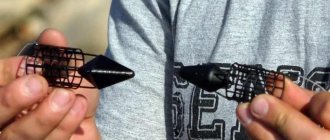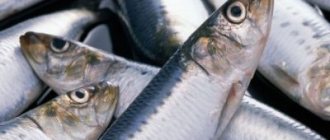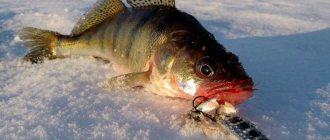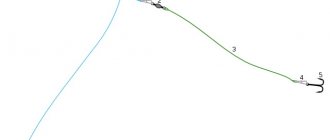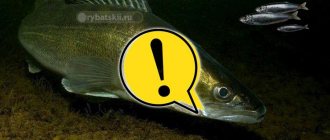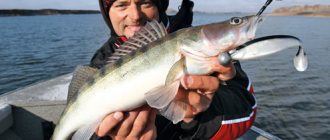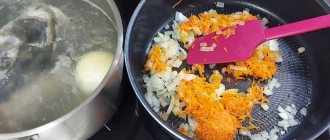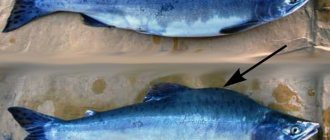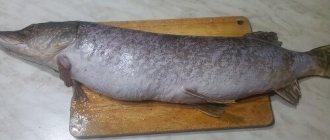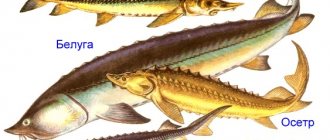Tulka is a small commercial sea fish belonging to the herring family.
Until recently, common sprat was divided into two subspecies. But as a result of the taxonomic revision, two independent species were identified - Caspian and Dzhargalen. The entire genus of kiln consists of 7 species. Are you making fish pies?
- Yes 82%, 292 votes
292 votes 82%292 votes - 82% of all votes
- No 14%, 50 votes
50 votes 14%
50 votes - 14% of all votes
- I don't eat fish 3%, 12 votes
12 votes 3%
12 votes - 3% of all votes
Total votes: 354
15.01.2020
×
You or from your IP have already voted.
Description
The average length of the fish is 11 centimeters and the weight is approximately 9 grams. But the body of some individuals can reach 15 centimeters in length. There are large specimens weighing up to 22 grams.
The sprat is easy to recognize by its external features. You can see what the sprat fish looks like in the photo. It has a strongly laterally compressed body and a well-developed ventral keel, which consists of approximately 27 - 28 scales.
The wide and large head of the sprat has an elongated shape. The upper jaw is slightly elongated relative to the anterior edge of the eye, and the lower jaw is extended slightly further than the upper.
The back of the sprat can be painted in colors ranging from gray-green to bluish-green. The photo shows that the color of the abdomen and sides can be golden-yellow or silver-white.
The lifespan of fish is approximately 5 years. The period of sexual maturity of the sprat begins when it reaches 5 centimeters in length. Spawning lasts from April to the end of August, with a peak in May. The water temperature for spawning is not a decisive factor; it can occur at 5 or 25 degrees. It is important for the development of eggs. They develop in 25 hours at a temperature of 10˚, and it will take up to 98 hours for the eggs to develop at a temperature of 20˚.
The food for sprat is zooplankton.
Composition and calorie content
100 grams of fish meat contains 88 kcal, of which 18 kcal are fats and 70 kcal are protein calories. The number of calories may vary depending on how the fish is prepared.
Salted, baked or boiled sprat has low calorie content, but when frying it increases significantly.
Nutritional value of 100 grams of product:
- Proteins – 17.5 grams,
- Fats – from 4 to 26 grams, depending on the cooking method,
- Carbohydrates – 0 grams.
Do you like salted fish?
- Yes 99%, 231 votes
231 votes 99%231 votes - 99% of all votes
- No 1%, 2 votes
2 votes 1%
2 votes - 1% of all votes
- I don't eat fish 0%, 1 vote
1 vote
1 vote - 0% of all votes
Total votes: 234
27.09.2019
×
You or from your IP have already voted.
Sprat meat is beneficial for humans due to its content of calcium, phosphorus, potassium, magnesium, chlorine, sulfur, iron, zinc, molybdenum, nickel, chromium and PP vitamins,
B1 and B2.
Habitat
The sprat fish is found in the waters of the Black, Azov and Caspian seas, choosing desalinated areas for its habitat. With the onset of spring, there is a massive migration of Azov and Black Sea sprat to estuaries near the seas or to the mouths of rivers flowing into them. It can also enter rivers at a distance of approximately 70 kilometers. Today this fish is also found in lakes and reservoirs.
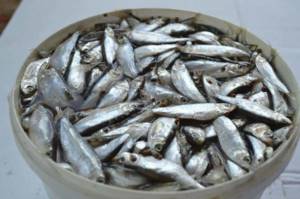
Beneficial features
Thanks to its composition, sprat is very beneficial for the human body.
- Calcium, contained in fish in huge quantities, takes an active part in the formation and strengthening of bones, dental tissue, hair and nails. Regulates blood clotting.
- Kilka is also rich in phosphorus, which is necessary for the body to fully absorb calcium. Since most of these microelements are contained in the backbone, tail and skin, the fish will be more beneficial if cooked whole. Phosphorus activates brain activity. Children who periodically eat sprat have better intelligence and less nervousness.
- The content of polyunsaturated fatty acids does not allow the development of vascular and heart diseases, hypertension and atherosclerosis. Polyunsaturated fatty acids are a natural antioxidant. By cleansing the human body of free radicals, it slows down the aging of the body.
- The amino acids present in fish are especially necessary for the female body and for older people.
Harm to the body
Due to the presence of so many beneficial properties in fish, it seems quite safe for human health. But you should be careful in using it, since there are a number of contraindications due to the method of its preparation.
- When salted, its salt content is almost 30% of the daily value. Therefore, it should not be used by people with high blood pressure, heart and vascular diseases, as well as kidney patients. If you have diseases of the gastrointestinal tract, you should avoid eating salted sprat.
- Canned sprat can be harmful to the human body because it uses excess salt and oil. Almost all manufacturers, when making canned food, give preference to cheaper types of oil, which have nothing useful in them. When eating fish in this form, the body can only get extra calories. The caloric content of sprat canned in oil is approximately 320 kcal per 100 grams, and the caloric content of the same fish cooked in its own juice does not exceed 200 kcal.
Important! Even in the absence of the listed diseases, some people may have individual intolerance to the product.
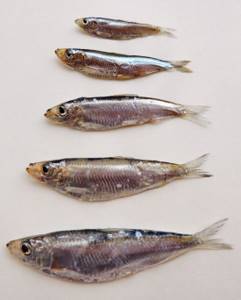
Tulka in cooking
This small fish is widely used in cooking. It is useful for its relatively low calorie content (88 kcal), the presence of a large amount of Omega-3 polyunsaturated fats, amino acids, vitamins (in particular PP), iodine, fluorine, phosphorus, chlorine, calcium.
Thanks to everything, sprat meat is useful for those who have heart problems and suffer from atherosclerosis. Fish will help keep your nails, bones, and hair healthy for a long time. It helps normalize cholesterol in the blood.
Tulka is prepared in different ways. It is fried, stewed, boiled, dried, salted; Canned sprat can also be prepared at home. Of the latter, those made with the addition of tomato are especially good.
As a rule, sprat is eaten whole. This allows you to receive more calcium, which is found in its skin, tail, and bones. When frying or stewing, the latter soften so much that their eating is simply not noticed.
There are no contraindications for consuming sprat. Only those people who are allergic to everything that comes from the sea cannot eat it.
Recipes for sprat dishes
Sprat cutlets
This dish is easy to prepare. The sprat is defrosted (if you bought one), washed, cleaned (the insides and heads are removed. The rest is left. Then the carcasses are passed through a meat grinder.
A loaf of fish (pre-soaked in milk), spices, eggs, and salt are added to the resulting minced fish. Finely chopped onions wouldn't hurt. Mix everything and beat it.
Then they take some of the minced meat, form cutlets and fry them. The latter can be done. Immediately place the pieces on a hot frying pan. Most housewives first roll them in flour and breadcrumbs.
Pickled sprat recipe
This recipe is more complicated than the previous one, and you will need more additional ingredients. Among the latter, except, of course, the sprat itself, of which they take, for example, a kilogram, prepare: 6 tablespoons of vegetable oil, an onion, small carrots (2 pieces), garlic (3 cloves), half a glass of 9% table vinegar, half a glass of water , laurel (1 leaf). To prepare sprat you will need pepper and salt.
The sprat is marinated in the following sequence:
- prepare the marinade:
- peel garlic and onions; cut them coarsely;
- peel the carrots, cut them into circles;
- fill a large bowl with vinegar and oil; add chopped onions, carrots, garlic; pour in water; salt with two pinches of salt; they throw laurel and pepper; mix everything;
- place the bowl on the fire, heat to a boil;
— the kilns are cleaned, the entrails are removed, and the heads are separated; salt and leave for 2 hours. salt;
- after the fish are rinsed with water, placed in a glass or porcelain mold;
- pour the marinade prepared earlier and brought to a boil over the laid out sprat;
— in a day the sprat will be pickled.
Kinds
The following types of sprat are distinguished:
- Ordinary, which is divided into Caspian and Azov,
- Black Sea Caspian sprat,
- Abrauskaya,
- Anchovy,
- Big-eyed.
Azovskaya
Common sprat is classified into two subspecies – Azov and Caspian. In the waters of the Azov Sea, it is the most numerous species of herring fish. In its best years, its catch was close to 120 thousand tons. If we conditionally divide all the sprat inhabiting Azov among all the inhabitants of the planet, then there will be 15 fish for each person.
The habitat of this species of the herring fish family is the Sea of Azov and desalinated Black Sea waters. In the Azov Sea, in winter it lives in open waters, and in spring it moves closer to the shore. It also feels great in reservoirs.
Fish spawning in the Azov water area occurs in May, when the water heats up to 15 - 20°C.
Kulka is a link in the food chain, as it is used as a food source for some predatory fish species. The fish itself eats copepods. In addition, their diet includes various organisms of plant and animal origin that live in the water column.

Often schools of fish in the Sea of Azov can be seen while swimming directly from the beach. Sprat are caught using fixed and purse seines, but you cannot find it in recreational fishing. The bulk of the caught fish is salted and sold to the public in this form. When smoked, it has practically no competitor in terms of taste characteristics.
Important! The fish reaches its greatest fatness in the autumn, when the fat content in it reaches up to 18.5%. The fat accumulated before the start of a long winter practically drips from it, for which it is figuratively called “an ampoule of fat.”
What do sprat and sprat have in common and their differences?
Both species are members of the herring family and belong to commercial fish species. Russia, Ukraine, Bulgaria, as well as other countries are on the list of large producers of this fish. Experts have decided to combine two subspecies of the herring family, sprat and sprat, into one species. The global catch in one year is about 250,000 tons of fish in one year. It is found in the Baltic, Caspian, Black Sea, Azov Seas, the Mediterranean, and also in the northern part of the Atlantic Ocean. But of all these species, it is generally accepted that the sprat lives in the Caspian, in the Azov-Black Sea region, as well as in some large freshwater rivers. Therefore, you can find Caspian or Black Sea sprat on sale. Sometimes in some regions the same fish can be sold as sprat.
Part of the catch is processed into bone meal, while the rest is sold. In supermarkets and markets, sprat and sprat can be bought as fresh-frozen fish and ready-to-eat fish: smoked, salted and canned. In terms of taste, sprat is almost no different from sprat, and eating it is considered beneficial for the body at any age.
How to cook and serve
This small fish is actively used in the culinary field. Many housewives love to cook it because the fish scales are easy to clean.
There are many ways to prepare this fish: it is salted, smoked, fried, dried and delicious soups are prepared from it. Also, some housewives prepare canned food from it.
Boiled or baked sprat fish is an excellent option for dietary nutrition, since it does not contain carbohydrates at all.
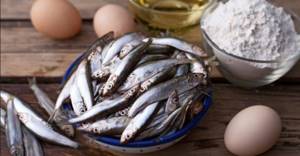
Dishes made from it are suitable for any table. As a side dish, you can serve rice porridge, buckwheat or boiled potatoes, adding butter to it. Dried fish is an excellent addition to low-alcohol drinks: a glass of beer or kvass.
Using sprat as live bait
Many fishermen use sprat as live bait when hunting a wide variety of fish at different times of the year. They use freshly caught fish, which are immediately placed on the hook; are being prepared for future use. In the latter case, the caught fish are placed in plastic bags (usually one quantity of fish that will be needed for one fishing trip) and frozen. If necessary, take a separate bag out of the freezer, defrost the fish and use them as bait for fishing.
Fishing with girders on sprat
With this method of fishing, standard girders are used, but they are supplied not with live bait, but with dead fish - sprat. For pike fishing, this option is of little interest, since the toothy one is caught in places where there is no or weak current, so the bait in the water looks unnatural and rarely attracts pike.
Most people hunt pike perch and bersh this way. To catch such fish, girders are placed at great (15...20 m) depths, in places where there is a noticeable current. It is these areas that are promising for fishing for these fish.
Fishing for pike perch and bersha with sprat involves equipping the girders with heavy (up to 40g) weights that can quickly deliver the bait to the desired depth, preventing the current from carrying the tackle far from the chosen place and strongly “sailing” the fishing line.
In such gear for bersha in winter on sprat, the main line itself is more important - it is long enough, since you need to lower the bait 20 m, so it can, after landing the prey, curl and form a “beard”. Therefore, it must be placed on vents measuring at least 0.3 mm.
The gear must use working equipment made of thinner (0.2...0.24 mm) fishing line. This is important, because both pike perch and bersh are cautious fish and react sensitively to rough gear. For catching bersh and pike perch with sprat, two types of working equipment can be used:
Similar to the Moscow jig, where there is a branch on which a load is placed, and a 1.5...2-meter piece of fishing line, at the end of which a hook is attached; this option is good in strong underwater currents, when both the hook and the sprat attached to it move away from the sinker and the tackle does not get tangled;
A load is tied to the end of the main lung, and above it there are 1...2 floods with hooks; this option of fishing with sprat is suitable for both strong and weak currents; it is as catchy as the previous one.
The effectiveness of catching pike perch and bersh on zherlitsa when fishing with sprat in winter is explained by the fact that in this process it is not at all necessary to play with bait. For predators, a sprat dangling under the influence of the current is enough.
How to put a sprat on a hook
In the girders, which are used for catching winter pike perch using sprat, double or treble hooks are used. They hook the fish on them in different ways: more often they do it by the back, by the head; Some fishermen prefer to cut the sprat in half and place it on two hooks at once.

